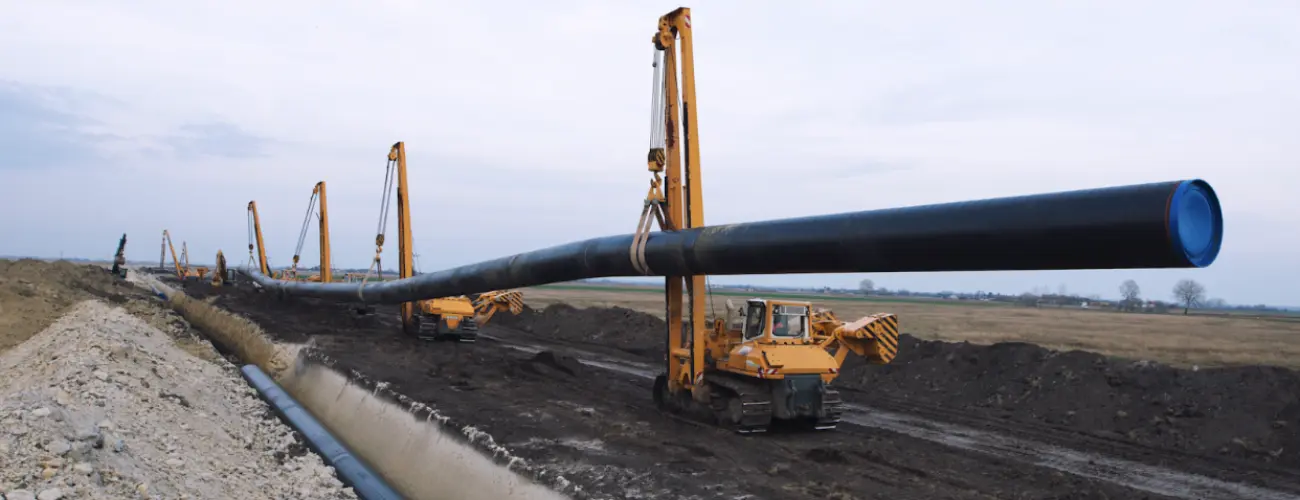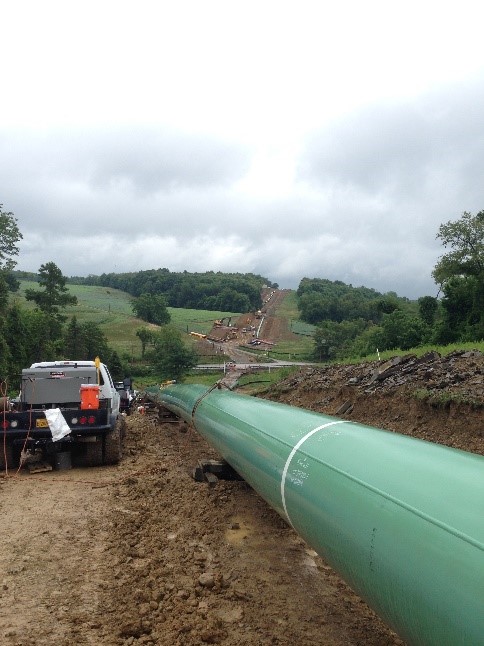The Environmental Impact With Creek Pipe HDPE installation Techniques
The Significance of Pipeline Construction: Discovering the Solutions Offered in the Sector
Pipeline construction is a critical element of modern framework. It facilitates the transportation of essential resources like oil, gas, and water. The sector includes different services, including planning, site preparation, and setup. Each stage requires precision and adherence to safety requirements. As areas depend on these systems for their livelihoods, recognizing the complexities of pipeline construction exposes its importance and possible difficulties. What aspects influence the success of these jobs?
Review of Pipeline Construction Services
Pipeline construction solutions incorporate a range of specific tasks designed to help with the installation of pipelines for carrying different substances, including oil, gas, and water. These services usually include website prep work, excavation, setup of pipe sectors, and backfilling. Competent labor and sophisticated equipment are fundamental for guaranteeing each phase is executed with precision and safety.Safety procedures are paramount, as these jobs typically include dealing with unsafe products and in difficult settings. Quality assurance procedures determine that the pipelines meet industry standards and guidelines. Additionally, the services may involve trenchless innovation, which decreases surface disruption.Environmental considerations play a significant function in pipe construction, needing evaluations and reductions to secure bordering ecological communities. On the whole, pipeline construction services are essential for developing the infrastructure essential for energy and water circulation, sustaining both financial development and social demands.
Preparation and Layout in Pipeline Projects
Reliable planning and layout are important parts of effective pipe tasks, making sure that all elements are diligently resolved prior to construction starts. This phase includes thorough feasibility researches that evaluate the technological, economic, and environmental aspects influencing the task. Engineers and designers work together to develop detailed plans that lay out the pipe course, materials, and construction approaches, straightening with regulatory demands and industry standards.Advanced software and modeling strategies are often used to simulate numerous circumstances, maximizing the style for performance and safety. Environmental effect evaluations are carried out to mitigate potential damage to environments and communities, mirroring a dedication to lasting techniques. Additionally, stakeholder interaction is important, fostering interaction and dealing with issues from affected celebrations. Eventually, effective preparation and style set the foundation for a pipeline project, lessening dangers and making sure a streamlined construction procedure, eventually adding to the total success of the procedure.
Site Preparation and Excavation
Detailed website prep work and excavation are crucial action in the pipeline construction procedure. This phase entails an in-depth assessment of the land where the pipe will be set up. Task teams carry out surveys to determine soil kinds, topography, and existing utility lines to guarantee a safe and reliable excavation. Correct site prep work reduces ecological effect and facilitates smoother construction operations.Excavation complies with, where heavy machinery is used to get rid of soil and rock, producing a trench that fulfills the specified deepness and width for the pipeline. This procedure needs to follow safety regulations and environmental guidelines to stop damage to bordering ecosystems.Additionally, erosion control actions are implemented to support the website during and after excavation. Reliable website preparation and excavation contribute greatly to the overall success of pipeline projects, laying a solid foundation for the succeeding stages of construction.
Pipeline Installation Methods
Pipeline installation strategies are vital for the effective application of infrastructure jobs. Two famous approaches include trenchless modern technology, which minimizes surface area disturbance, and the open-cut excavation procedure, understood for its straightforward technique. Each technique uses unique benefits and considerations depending on project demands and ecological variables.
Trenchless Technology Approaches
While typical approaches of pipeline setup frequently involve extensive excavation, trenchless innovation methods provide a much more effective and eco-friendly option. These cutting-edge methods, such as horizontal directional drilling and pipe bursting, minimize surface disturbance by enabling the setup of pipelines without considerable digging. This not only reduces the environmental influence however likewise considerably lowers labor and remediation prices. Trenchless approaches facilitate the setup of pipes in city locations where traditional excavation would certainly be not practical or destructive to existing framework. Additionally, these techniques can suit numerous soil kinds and conditions, making them flexible remedies for pipe construction. Inevitably, trenchless modern technology stands for a substantial innovation in the pipe industry, advertising sustainability and operational performance.

Open-Cut Excavation Process
Open-cut excavation remains a fundamental method in pipe installment, identified by the straight excavation of see this a trench to lay pipelines. This approach entails water heater overflow pipe getting rid of soil and various other products to develop a trench of sufficient depth and width, enabling the placement of pipes at the needed grade. Open-cut excavation is typically favored for its cost-effectiveness and simplicity, particularly in locations with stable dirt conditions. Nonetheless, it can interfere with surface area activities and requires careful planning to handle traffic and environmental impacts. Precaution have to be implemented to secure workers and close-by facilities throughout the excavation procedure. In general, while open-cut excavation might not appropriate for all terrains, it stays a commonly made use of method in pipeline construction.
Checking and Quality Control
Testing and quality control are essential elements in pipeline construction, ensuring that installments satisfy recognized security requirements and performance requirements. Various examination methods and techniques are used to examine material quality and adherence to regulatory compliance. This systematic method helps identify potential issues prior to they rise, protecting the integrity of the pipe system.

Assessment Techniques and Approaches
Evaluation strategies and techniques are vital elements in guaranteeing the stability and safety of pipe construction. Various methods, consisting of aesthetic evaluations, ultrasonic testing, and radiographic assessments, are employed to detect issues and confirm quality. Visual assessments enable the identification of surface anomalies, while ultrasonic testing uses sound waves to evaluate wall surface thickness and locate flaws internally. Radiographic examinations involve X-rays or gamma rays to generate pictures of the pipeline's structure, exposing concealed issues. In addition, stress testing is conducted to examine the pipeline's integrity under operational problems. These approaches jointly add to a detailed understanding of the pipeline's condition, making it possible for timely upkeep choices and making certain compliance with sector standards. Effective inspection is essential for protecting against failures and promoting long-term functional safety and security.
Safety Requirements Compliance
Making sure conformity with safety requirements is critical in pipe construction, as it directly influences the job's overall top quality and integrity. Complying with recognized laws and standards assurances that construction methods reduce risks connected with pipeline installation and procedure. Creek Pipe Texas oilfield. Extensive testing methods, consisting of non-destructive testing and stress assessments, are critical in validating that pipes can stand up to the functional stress and anxieties they will certainly experience. Quality guarantee steps are additionally crucial, as they establish a structure for consistent monitoring and analysis throughout the construction process. By prioritizing safety requirements compliance, business not only secure employees and the atmosphere however likewise enhance the integrity of the pipe, eventually leading to lasting operational success and public rely on the facilities
Material Quality Examination
Material high quality assessment plays a significant duty in the general integrity of pipe navigate here construction. This procedure includes strenuous testing and quality control steps to guarantee that materials fulfill market criteria and specifications. Numerous tests, including tensile toughness, deterioration resistance, and weld stability analyses, are carried out to determine any type of possible weaknesses. A detailed examination not only assures the efficiency of the pipeline yet additionally boosts safety and toughness over its life-span. In addition, applying high quality control methods assists minimize risks connected with material failures, which can bring about expensive repair work and environmental dangers. By focusing on worldly top quality evaluation, companies can assure compliance with governing requirements while fostering self-confidence amongst stakeholders in the dependability of their pipeline systems.
Repair And Maintenance Services
Repair and maintenance services play a vital duty in the longevity and performance of pipeline systems. These solutions include routine examinations, fixing, and rehabilitative actions to attend to wear and tear, leakages, and various other issues that might emerge with time. Knowledgeable service technicians use advanced technologies such as ultrasonic testing and clever pigging to check pipe stability, guaranteeing that any possible problems are identified early.Additionally, upkeep programs often consist of arranged safety nets developed to enhance system integrity and lower the possibility of unanticipated failures. Repair solutions might involve the substitute of broken sections, securing leakages, or utilizing trenchless technology for very little disturbance.
Environmental Conformity and Security Actions
Pipeline systems not only need ongoing repair and maintenance to function effectively but likewise have to abide by rigid ecological conformity and precaution. These regulations are vital for minimizing ecological impact and ensuring public security. Companies in the pipe construction market apply detailed environmental evaluations before job initiation, determining potential risks to wild animals and ecosystems.Furthermore, adherence to security protocols protects workers and bordering neighborhoods. This includes normal training on emergency situation response and spill avoidance techniques.To maintain compliance, industries utilize keeping track of modern technologies to find leaks and various other anomalies in real-time. Environmental administration plans are often developed to describe steps for dealing with unpredicted concerns throughout construction.Ultimately, rigorous adherence to ecological conformity and precaution not only fulfills lawful responsibilities yet also cultivates lasting methods within the market, advertising a balance in between infrastructure development and environmental stewardship.
Frequently Asked Concerns
What Career Opportunities Are Available in Pipeline Construction?
Profession opportunities in pipeline construction encompass functions such as job managers, engineers, welders, and safety and security inspectors. These positions call for diverse skills, offering pathways for development in a necessary sector of framework development and power circulation.

Just How Do Pipeline Projects Influence Local Communities?
Pipeline tasks greatly affect regional areas by influencing economic development, offering task chances, and boosting infrastructure. They may likewise raise issues concerning environmental results, land use, and possible disruptions to neighborhood cohesion and natural ecosystems.
What Technology Is Made Use Of in Modern Pipeline Construction?
Modern pipeline construction utilizes innovative innovations such as GIS for mapping, drones for aerial surveys, and automated welding systems to enhance performance, security, and accuracy, inevitably promoting the efficient transportation of sources across different surfaces. Creek Pipe near me.
Exactly How Are Pipeline Construction Prices Estimated?
Pipeline construction costs are estimated with detailed evaluations of products, labor, devices, and governing needs. Aspects like surface, project dimension, and environmental factors to consider additionally considerably influence the general budget and financial preparation for construction.
What Are the Greatest Difficulties in Pipeline Construction Projects?
The biggest challenges in pipe construction tasks consist of regulative compliance, ecological concerns, logistical problems, securing financing, and handling labor scarcities. Each variable can greatly impact timelines and budget plans, complicating the general execution of the project.